TRENDING TAGS :
Plant trees 'Dil Se': Indian scientists in United States
After the Maldives Incident, Shift Your Focus to Sri Lanka: Your Ultimate Travel Guide
Louisville: Planting a sample of seeds would be much more effective than taking medications to prevent heart disease. For this, scientists are trying to scrutinise the connections between health and trees.
Aruni Bhatnagar, a medical professor at the University of Louisville along with other team members, unveiled the $14.5 million 'The Green Heart Project' which will transform four South Louisville regions with as many as 8,000 trees and other plantings.
The area involves Churchill Downs, Iroquois Park and Louisville International Airport. About 22,000 Louisvillians reside in these areas.
The air pollution expert stated, "We think trees might be more effective than statins, as the widely prescribed class of drugs used to lower blood cholesterol is a risk factor for heart disease and stroke."
The Green Heart Project

The project involves the University of Louisville, The Nature Conservancy, The Institute of Healthy Air, Land, Soil and a few other partners.
Trees, shrubs and other plants will be placed where they can best soak up lung-damaging air pollution, like along the Watterson Expressway or other busy roads within the study area.
ALSO READ: ATTENTION | Watching hockey can be stressful for your heart?
The Green Heart Partners stated, "The study seeks to add more certainty to earlier research that is associated trees with improved public health but has fallen short on definitive conclusions and details.
Trees have their own way to breathe. They intake carbon dioxide and breathe out oxygen. While trees also produce organic compounds, a source of ozone pollution. They also absorb ozone and other pollutants and trap especially dangerous tiny particles.
What does Aruni Bhatnagar say about the Green Heart Project?

Nobody has evaluated the specific health effects of planting green spaces. There have been no other studies like it, where people's health is monitored before, during and after a major, neighborhood-scale tree planting.
Under this project, we will compare the health of people living near the newly planted greenery to those who live elsewhere. We are hopeful to see changes in few years.
It is like a drug trial with nature as a drug.
Director of Urban Conservation Chris Chandler said:
Instead of giving someone a pill, we are giving them greenness.
The trees will be some of the largest that will be able to be transplanted.
It will be a really unique urban laboratory.
With guidance from the public, Green Heart team members will be deciding where and what to plant based on what's best for reducing air pollution. That could include obtaining permits to plant in state and federal rights of ways, as well as permission from property owners.
ALSO READ: World Heart Day | How to keep your heart healthy as you age
Trees also could be planted at homes, churches, schools, businesses and parks, along with shrubs and native grasses and other plants.
Nobody in the four neighborhoods will be told not to plant trees nor will any other tree planting initiatives there be discouraged.
Executive director of philanthropist Christy Brown's air, water and soil institute Veronica Combs stated:
We are going to build a relationship with the community.
The institute has identified 200 community leaders and begun to meet with them. We are getting their feedback.



